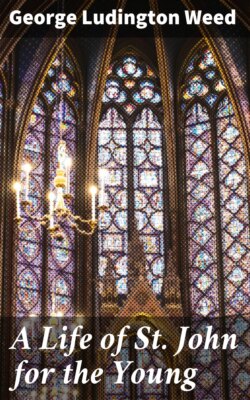Читать книгу A Life of St. John for the Young - George Ludington Weed - Страница 12
На сайте Литреса книга снята с продажи.
Calm on Galilee—From Photograph Page 26
ОглавлениеIn another hour they watch the more quiet movements of pleasure boats—gay barges and royal galleys—and trading vessels, and fishing boats—all crowding together seemingly covering the lake.
As it narrows in the southern distance, the Jordan commences the second stage of its journey of one hundred and twenty miles through rugged gorges. As it leaves the quiet lake, we can almost hear them saying to it
"Like an arrow from the quiver,
To the sad and lone Dead Sea,
Thou art rushing, rapid river,
Swift, and strong, and silently,
Through the dark green foliage stealing,
Like a silver ray of light."
Descending from the hill we may follow James and John in their rambles in the region near their home. On the northern extremity of the lake, among the colossal reeds, and meadow grass and rushes, they watch the little tortoises creeping among them; and the pelicans which make them their chosen home; and the blue and white winged jays that have strayed from the jungles through which the Jordan has pushed its way; and the favorite turtle-doves; and the blue birds so light that one can rest on a blade of grass without bending it; and the confiding larks and storks which, not fleeing, seem to welcome the visitors to their haunts. Here grow oleanders of such magnificence as is seen nowhere else in the country, twenty feet high, sometimes in clumps a hundred feet in circumference; and "masses of rosy red flowers, blushing pyramids of exquisite loveliness."
Our ramblers follow the western shore to the shallow hot stream, where boy-like—or manlike as I did—they burn their hands in trying to secure pebbles from its bottom. They rest under the shade of an olive or a palm. They gather walnuts which are in great abundance; and grapes and figs, which can be done ten months in the year; and oranges and almonds and pomegranates.
They wander through meadows rich in foliage, and gay with the brightness and richness of flowers which retain their bloom in Galilee when they would droop in Judæa or Samaria.
We hear the poet Keble asking them,
"What went ye out to see
O'er the rude, sandy lea,
Where stately Jordan flows by many a palm,
Or where Gennesaret's wave
Delights the flowers to lave,
That o'er her western slope breathe airs of balm?
"All through the summer night,
These blossoms red and white
Spread their soft breasts unheeding to the breeze,
Like hermits watching still,
Around the sacred hill,
Where erst our Saviour watched upon His knees."
To the poet's question James and John would answer that they "went out to see the blue lupin and salvia, the purple hyacinth, the yellow and white crocus, the scarlet poppy, and gladiolus, the flowering almond, the crimson and pink anemone."
They also saw the cultivated fields, and the sower casting his seed which fell on the hardened pathway, or barren rocks, or bounteous soil. They watched the birds from mountain and lake gather the scattered grain. They thought not of the parable into which all these would be weaved; nor of Him who would utter it in their hearing near where they then stood. They saw the shepherds and their flocks, the sparrows and the lilies, that became object lessons of the Great Teacher yet unknown to them. In their rambles they may have climbed the hill, only seven miles from their home, not thinking of the time when they would climb it again; after which it would be forever known as the Mount of Beatitudes.
Such were some of the charming and exciting scenes with which John was familiar in his early life, and which would interest his refined and observing nature, of which we know in his manhood. They must have had an important influence in the formation of his character.
We have spoken of five Bethsaidan boys—Andrew and Peter, James and John—and a friend. His name was Philip. We know but little of him. What we do know is from John. He tells us that "Philip was of Bethsaida, the city of Andrew and Peter." Perhaps he was their special friend, and so became one of the company of five, as he afterward became one of the more glorious company of twelve. We shall find three of these five in a still closer companionship. They are Peter, James and John. One of these shall have the most glorious honor of all. It is John.
